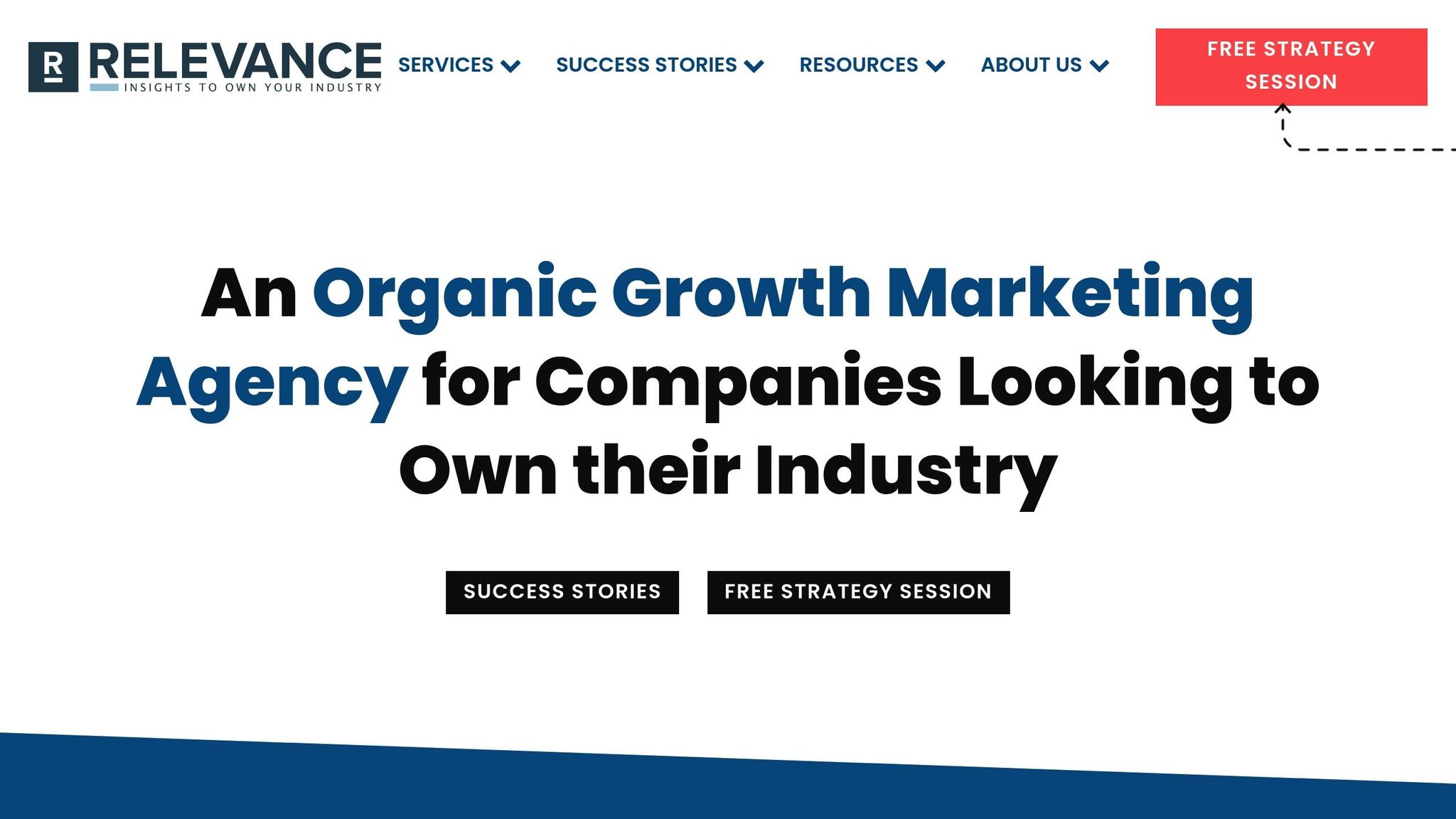Last Updated on July 21, 2025 by Becky Halls
Backlinks are still a key factor for SEO success in 2025, but it’s no longer about quantity – it’s about quality, relevance, and authority. Proper backlink placement can significantly boost rankings and drive traffic. Here’s what you need to know:
- Audit Your Backlinks: Use tools like Ahrefs or Semrush to identify harmful links, high-value pages, and areas for improvement. Remove toxic links to avoid penalties.
- Focus on Quality Over Quantity: Links from relevant, high-authority sites within engaging content are far more impactful than large numbers of low-quality links.
- Content Matters: Create link-worthy content like research studies, guides, or interactive formats to naturally attract backlinks.
- Placement is Key: Contextual links within the main body of articles outperform those in footers or sidebars.
- Diversity Wins: Build a varied backlink profile with links from different domains and industries.
- Track Performance: Monitor metrics like referring domains, domain authority, and referral traffic to refine your strategy.
Beginner’s Guide to Creating Backlinks For SEO [2024]
Review Your Current Backlink Profile
Before diving into new link-building efforts, it’s crucial to evaluate what you already have. A detailed backlink audit helps you understand your current strengths, weaknesses, and areas for improvement, laying the groundwork for a solid backlink strategy.
Run a Backlink Audit
A backlink audit is essential for pinpointing harmful links and uncovering new opportunities for growth. It not only sheds light on your link profile’s performance but also provides valuable insights into what your competitors are doing.
To get started, choose a tool that matches your budget and needs. Options like Ahrefs, Moz, Semrush, or even the free Google Search Console can provide the data you need.
Evaluate your backlink profile using key metrics such as total backlinks, referring domains, dofollow-to-nofollow ratio, and authority scores. For example, Ahrefs offers detailed metrics like Domain Rating, while Moz’s Spam Score gives a quick snapshot of how spammy a backlink profile might be.
Take a closer look at the types of links you already have – like guest posts, niche edits, or roundups. This can guide your future campaigns. Also, scan your backlink list for opportunities to replicate successful links, whether through press mentions, partner pages, directories, or blog posts.
Find Your High-Value Pages
Identify the pages on your site that already attract backlinks. These pages can serve as inspiration for creating similar content that draws links naturally.
Look at your competitors’ backlinks for ideas and consider updating outdated resources to attract new links. Strengthen your internal linking strategy by redistributing authority from high-performing pages to those that could use a boost. If you notice pages with strong backlink profiles but little search traffic, refreshing the content could help unlock their potential.
Once you’ve identified your high-value pages, it’s time to address harmful links.
Spot and Remove Toxic Backlinks
Toxic backlinks can negatively impact your rankings, so it’s important to identify and address them. Tools like Google Search Console and Moz can help you spot spammy links from link farms, private blog networks (PBNs), or unrelated comments. Pay attention to anchor texts with irrelevant terms like “casinos”, “loans”, or “pharmaceuticals”, as these often signal problematic links.
Many backlink tools provide automated reports, such as a “spam score” or “toxicity meter”, to help you identify harmful links. Once flagged, export the list of toxic links and disavow them using Google Webmaster Tools.
If you discover toxic links, reach out to the referring website and request removal or ask them to add a “nofollow” attribute. Be specific in your outreach by including the link’s location and explaining why it should be removed. If you don’t get a response after a few days, follow up. Should your efforts fail, use Google’s Disavow Links tool to nullify the links. When disavowing, it’s usually better to target entire domains rather than individual URLs. If your site has been hit with a manual action, consider submitting a reconsideration request through Google Search Console.
“Links obtained primarily for artificial manipulation of Search rankings are link spam. Our algorithms and manual actions aim to nullify these unnatural links at scale, and we will continue to improve our coverage.” – Google
Make a habit of monitoring and updating your backlink profile to avoid negative SEO attacks and recover lost links. Regularly check for broken or lost links (often leading to 404 errors) and reach out to webmasters or update your site’s redirects to recover those links.
Create a Quality-Focused Backlink Strategy
Once you’ve refined your backlink profile, the next move is to develop a strategy that prioritizes quality over quantity. Search engines reward websites that earn links organically through relevance and genuine value. While this approach demands more effort upfront, it pays off in the long run by boosting your site’s authority and improving your search rankings.
Here’s how you can create content and execute outreach efforts that naturally attract high-quality backlinks.
Build Content That Attracts Links
The backbone of any effective backlink strategy is creating content so compelling that other sites can’t help but reference it. To achieve this, your content must be informative, engaging, and packed with value. This requires thoughtful planning and original insights.
Start by producing content that offers unique perspectives or exclusive data. Think research studies, industry surveys, or in-depth data analysis. For instance, blogging consistently has been shown to generate 67% more leads than not blogging at all.
Dive deeper with comprehensive guides, case studies, or reports that solve specific problems for your audience. Take Buffer, for example – they’ve crafted extensive resources like their guide to Instagram marketing, which is loaded with charts, images, and examples. This kind of detailed content naturally earns backlinks over time.
Incorporate engaging formats like infographics, videos, and interactive elements to make your content more shareable. A great example is Movoto’s collaboration with Fractl on the “Marvel Origins” infographic. This creative project tied Marvel Comics characters to real estate and earned coverage in 365 stories across major outlets like Yahoo, Mashable, and MTV.
Lastly, covering trending topics with a fresh angle and original insights can help your content stand out and gain attention quickly.
Use Guest Posting to Earn Links
Once you’ve built link-worthy content, guest posting can take your backlink strategy to the next level. It’s still a reliable way to secure quality backlinks while building your authority in the industry.
Start by identifying guest posting opportunities using Google search operators like “your industry + write for us” or “your niche + guest post.” You can also analyze competitors’ backlink profiles to uncover where they’ve guest posted.
Social media platforms like LinkedIn and Twitter are excellent tools for finding opportunities and connecting with content managers or influencers. Once you’ve identified potential sites, review their previous guest posts to understand their submission guidelines and tailor your pitch to their audience.
For an efficient approach, tools like 3Way.Social can help you connect with high-authority websites through AI-powered domain matching.
Apply Digital PR and Outreach Methods
Digital PR blends traditional public relations with online strategies to secure valuable backlinks from blogs, online publications, and podcasts. This method not only boosts your backlink profile but also enhances your visibility and credibility.
Create original research, surveys, or studies that offer journalists and bloggers newsworthy insights. Interactive content, such as quizzes, calculators, or infographics, can also engage your audience and encourage sharing.
Another effective tactic is newsjacking – capitalizing on trending news to gain media coverage. Building relationships with niche media outlets by providing expert commentary or helpful resources can further position your brand as a go-to authority.
Don’t overlook the potential of converting unlinked brand mentions into backlinks. If a publication is already mentioning your brand, reaching out to request a link can be a quick win. Additionally, incorporating multimedia elements like videos, podcasts, and webinars into your digital PR efforts can significantly increase sharing potential – visual content alone is 40% more likely to be shared.
sbb-itb-88880ed
Place Backlinks for Best SEO Results
Once you’ve built a solid content and outreach strategy, the next step is focusing on where and how to place backlinks for maximum SEO impact. It’s not just about getting links – it’s about securing ones that both search engines and users find valuable. Thoughtful placement can significantly improve your search visibility and overall site credibility.
Focus on Contextual Relevance

Contextual relevance is at the heart of effective backlinking. Links placed naturally within related content carry more weight. In fact, 84.6% of SEO professionals consider link relevance the most important factor when evaluating backlink quality.
Google’s algorithms are now skilled at assessing how well a backlink fits into the broader context of the page. They use tools like topic embeddings and web entity analysis to determine if a link genuinely adds value. For example, a review article on SEO tools linking to Sitechecker as an alternative makes sense because it aligns with the topic and provides useful information to readers searching for “Best SEO tools for auditing websites”.
Thematic alignment is key. A backlink from a relevant, lower-authority blog can sometimes be more impactful than one from an unrelated high-authority site. For instance, if you run a financial services website, a link from a niche financial blog may carry more SEO weight than one from a high-profile tech site.
“All other metrics being equal, I’d go for relevance over authority. The simple reason for this is conversion. Sure, a link to a high-authority site does wonders for SEO, but how many people who see your link in that article would actually take interest in what you have to offer? In a high-relevance placement, chances are the reader has at least some tangential interest in your offer. Thus, there is a higher chance that they’re indeed looking for a service like yours.” – Tom Jauncey, CEO at Nautilus Marketing
When building contextual links, pay close attention to your anchor text. Avoid overloading it with keywords. Instead, use natural language that fits seamlessly within the content. Mix it up with branded terms, partial matches, and generic phrases to keep your profile diverse and penalty-free.
Target High-Authority Websites
While relevance is critical, authority also plays a major role in backlink success. Links from high-authority domains signal trust and credibility to search engines. Sites with domain authority scores above 60 can significantly boost your rankings.
But authority isn’t just about metrics. Look for websites with steady organic traffic, diverse backlink profiles, and consistent publishing histories. Older, well-established domains are often more trusted by both search engines and users.
The sweet spot is finding backlinks that combine relevance and authority. However, when forced to choose, some experts lean toward authority for its ranking power:
“If I had to choose between different types of links, I would certainly go with a link from a high authority website even if the link’s relevance is low. Building relevant links is important, perhaps more important than it ever was given the impact of Gen AI on content and search, but it’s the high authority links that really matter and count when it comes to link building.” – Shawn Plummer, CEO at Annuity Expert
To secure these high-authority links, focus on creating content that adds value and conducting genuine outreach. Remember, earned links – those that come from great content – are far more effective than bought or forced ones. Also, placement matters. Links embedded in the main body of an article carry more weight than those tucked away in footers or sidebars.
Vary Your Link Sources
A strong backlink profile isn’t just about relevance and authority – it’s also about diversity. Relying on a small number of sources can leave your SEO vulnerable. If those sources lose credibility or face penalties, your rankings could take a hit. A diverse backlink profile shows search engines that your site is trusted across different corners of the web.
To diversify effectively, aim for links from a mix of authoritative and niche-related websites. Even links from different but related niches can demonstrate to search engines that your content appeals to a broad audience while staying relevant.
Here’s how to keep your profile diverse:
- Use varied anchor text, including branded terms, exact match keywords, partial matches, and generic phrases like “click here” or “read more.”
- Include different link types, such as editorial links, guest post links, and directory links, to create a balanced profile.
- Explore platforms like 3Way.Social, which use AI to match domains and streamline link diversification, helping you secure high-quality backlinks from a variety of sources.
“By acquiring links from a mix of domains – whether through industry-specific websites, reputable blogs, or authoritative content hubs – you can build a strong and resilient backlink profile that helps your website stand out in a competitive digital landscape.” – Velir
Always prioritize quality over quantity. A diverse profile doesn’t mean accepting low-quality links just to check a box. Each link should meet your standards for relevance, authority, and overall value. The goal is to create a natural-looking backlink profile that strengthens your SEO efforts without cutting corners.
Monitor and Improve Your Backlink Performance
Once you’ve secured quality backlinks, the next step is making sure they’re actually working for you. Building backlinks is just the beginning – the real payoff comes from tracking their performance and tweaking your strategy based on the data. Keeping an eye on your backlinks is key to refining your approach and getting the most out of your SEO efforts.
Track Backlink Results
To measure success, you need to focus on the right metrics. Not all numbers are created equal – some are just vanity stats that don’t tell you much about your SEO performance. Instead, zero in on metrics that truly matter.
One critical metric? Unique referring domains. A single backlink from 10 different quality domains is far more impactful than 10 backlinks from one site. Google prioritizes diversity in your linking profile over sheer volume.
Use tools that provide accurate, up-to-date data and allow you to track trends over time. Often, combining insights from multiple tools gives you a fuller picture of how your backlinks are performing.
| Metric | What It Measures | Best Tools |
|---|---|---|
| Domain Authority (DA) | Predicts how well a site will rank in search engines | Moz Link Explorer, SEMrush, Ahrefs |
| Referring Domains | Number of unique domains linking to your site | Ahrefs, SEMrush, Moz |
| Traffic from Backlinks | Referral traffic generated by backlinks | Google Analytics |
| Anchor Text Distribution | The clickable text in hyperlinks | Ahrefs, SEMrush, Moz |
| Spam Score | Likelihood a site could be penalized | Moz Spam Score tool |
Keep an eye on the overall trend of your backlinks. Are you gaining or losing links over time? This helps you catch issues early, like links being removed or websites going offline. Pay close attention to metrics like your Authority Score, which reflects the overall strength of your domain.
Majestic SEO is another useful tool, offering Trust Flow and Citation Flow metrics. A high Trust Flow indicates strong, reliable backlinks, while a high Citation Flow paired with low Trust Flow could signal spammy links.
Also, track the number of links earned per campaign. This way, you can identify which tactics and content are driving the most valuable backlinks. If certain strategies are working, double down on them. If others aren’t delivering, it’s time to pivot.
Lastly, use Google Analytics to track referral traffic. High-quality backlinks should bring real visitors to your site. Did you know the top search result captures about 27.6% of all clicks? Optimized content can push that number even higher, up to 56%.
Update Your Strategy Based on Data
SEO isn’t a one-and-done process. It’s all about staying on top of trends, keeping up with industry changes, and constantly fine-tuning your approach. A data-driven mindset is key to long-term success – let your backlink metrics guide your decisions.
Regularly update your backlink data to monitor new and lost links. Automated reports can help you track important metrics like Domain Authority, Page Authority, and referral traffic, making it easier to spot trends and adjust your strategy.
Tools like Google Analytics and Google Search Console are invaluable for analyzing your performance. For example, Google Search Console has a G2 rating of 4.7/5 from over 400 reviews, with users praising its actionable insights and error resolution features.
When you notice that certain content or outreach strategies are outperforming others, shift your resources accordingly. For instance, if guest blogging on niche industry sites generates better backlinks than directory submissions, focus more on that approach.
“High quality content doesn’t just attract readers and move them through the customer journey – it sparks conversations and helps you become a reference point in your industry. When you combine valuable content with relationships built on meaningful conversations, backlinks become a natural result of your expertise.”
- Misty Larkins, President at Relevance
The results speak for themselves. In April 2025, Backlinko updated its SEO Trends article and saw a 70.43% boost in organic traffic. This example shows how refreshing and improving your content can dramatically improve backlink performance and overall SEO results.
Stay vigilant – search engine algorithms are always evolving. What worked six months ago might not work today. Keep monitoring trends, identify areas for improvement, and adjust your strategy based on the latest data.
For extra efficiency, consider platforms like 3Way.Social. Their AI-powered tools can simplify backlink monitoring and even help you find new opportunities for high-quality link exchanges with vetted partners.
Conclusion: Main Points for Better Backlink Placement
Getting backlinks from trusted sources is a cornerstone of any successful SEO strategy. With over 53% of website traffic coming from organic search, placing backlinks strategically can drive long-term digital growth with a high return on investment. However, quality always outweighs quantity – just one strong backlink can outperform thousands of weak ones. Regular audits and focused outreach are key to building a solid foundation for sustainable SEO.
The best backlink strategies combine three critical factors: contextual relevance, high domain authority, and natural anchor text. Case studies show how aligning these elements leads to better search engine rankings.
When building backlinks, aim for links from reputable and relevant sources within your industry. Prioritize dofollow links, as they pass link equity to boost your rankings. Consistent audits and relationship-building efforts help maintain a strong backlink profile, especially with editorial links that hold significant value in the eyes of search engines.
Statistics show that 85.7% of brands actively use link-building strategies. The most successful approaches focus on evaluating backlinks based on relevance, authority, and traffic. Additionally, using anchor text that feels natural and avoids spammy patterns helps maintain credibility with search engines.
For outreach and monitoring, tools like 3Way.Social can simplify the process. Their AI-powered platform matches you with vetted partners for secure, permanent dofollow links, making it easier to secure high-quality backlinks efficiently.
FAQs
What’s the best way to find and remove harmful backlinks that could hurt my website’s SEO?
To spot harmful backlinks, keep an eye out for links coming from spammy or unrelated websites, domains that seem suspicious, or sites filled with poor-quality content. Tools like Google Search Console can help you dig into your backlink profile and pinpoint these problematic links. Once you’ve identified them, you have two options: reach out to the website owners and ask them to remove the links, or use Google’s Disavow Tool to ensure those links don’t harm your site’s performance. Staying on top of your backlink profile through regular monitoring is crucial for keeping your SEO efforts on track.
How can I create content that naturally earns high-quality backlinks?
To attract strong backlinks, the key is to craft content that stands out and genuinely connects with your audience. Think along the lines of detailed guides, original research, eye-catching infographics, or interactive tools – things that offer real, actionable value.
Once your content is polished and ready to go, the next step is getting it in front of the right people. Reach out to publishers, bloggers, and influencers within your niche who would find your content relevant and appealing. When your content aligns with their interests and sparks engagement, the chances of earning backlinks naturally increase over time.
Why is contextual relevance important when placing backlinks, and how does it affect SEO?
Contextual relevance plays a key role in effective backlink placement, as it helps search engines grasp the connection between the linked content and the page it’s on. When backlinks are embedded in relevant, high-quality content, they come across as more natural and credible. This can lead to better rankings and an increase in your site’s domain authority.
On top of that, contextually relevant backlinks improve the user experience by guiding readers to useful, related information. This not only keeps users engaged but also signals to search engines that your site offers meaningful and valuable connections – giving your SEO strategy an extra boost.



